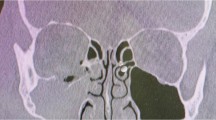Abstract
Several approaches are used to reconstruct orbital floor fractures and restore orbital position and function, but many have the drawback of incomplete visualization, especially of the posterior part of the orbit. The aim is to assess the validity and accuracy of endoscopically aided subciliary approach repair of orbital floor fractures, as regards functional and cosmetic outcomes. Nine patients with orbital floor fractures were treated with iliac crest bone graft under complete endoscopically aided visualization, through a subciliary approach graft that was placed over the defect under complete visual control using endoscopes, through the same incision, to reconstruct the defect and assess the correction of the posterior edge of orbital floor defect. Improvement was assessed 2 weeks postoperatively. All operated cases had satisfactory results, both functionally and cosmetically. No permanent drawbacks from the incision were observed at 6 months follow-up. In case of repair of orbital floor fractures via a transciliary approach, the use of endoscopic aid through the same incision, allows better visualization of the posterior edge of the orbital floor and facilitates confirmation that all orbital soft tissues have been accurately elevated from the fracture site and that the bone grafts are placed in proper position. Level of evidence: 1b (individual inception study with >80% F/U).




Similar content being viewed by others
References
Vriens JP, VanderGlas HW, Moos KF (1998) Infraorbital nerve function following treatment of orbitozygomatic complex fractures. A multitest approach. Int J Oral Maxillofac Surg 27(1):27–32
Naqasao T, Miyamoto J, Naqasao M, Oqata H (2006) The effect of striking angle on the buckling mechanism in blowout fracture. Plast Reconstr Surg 117(7):2373–2380
Eski M, Sahin I, Deveci M, Turegun M, Isik S, Sengezer M (2006) A retrospective analysis of 101 zygomatico-orbital fractures. J Craniofac Surg 17(6):1059–1064
Rosbe KW, Meredith SD, Holmes DK (1997) Complication of maxillary sinus Foley balloon placement for orbital floor support. Otolaryngol Head Neck Surg 117(6):148–150
Glassman RD, Manson PN, Vanderkolk CA (1990) Rigid fixtion of internal orbital fractures. Plast Reconstr Surg 86(6):1103–1109
Rohrich RJ, Hollier LH, Watumull D (1992) Optimizing the management of orbitozygomatic fractures. Clin Plast Surg 19(1):149–165
Goldberg RA, Garbuutt M, Shorr N (1993) Oculoplastic uses of cranial bone grafts. Ophthalmic Surg 24(3):190–196
Al-Sukhun J, Lindqvist C (2006) A comparative study of 2 implants used to repair inferior orbital wall bony defects, autogenous bone graft versus bioresorbable poly-4 dl-lactide plate. J Oral Maxillofac Surg 64(7):1038–1048
Woog JJ, Hartstein ME, Gliklich R (1998) Paranasal sinus endoscopy and orbital fracture repair. Arch Ophthalmol 116:688–691
Schon R, Metzger MC, Weyer N, Falder O (2007) Microplate osteosynthesis of orbital floor fractures. Br J Oral Maxillofac Surg 45(2):165
Kellman (2003) Endoscopically assisted repair of subcondylar fractures of the mandible: an evolving technique. Arch Facial Plast Surg 5:244–250
Katsuhisa I, Hideaki S, Takeshi O, Tomonori T (1999) Endoscopic endonasal repair of orbital floor fracture. Arch Otolaryngol Head Neck Surg 125:59–63
Naraghi M, Kashfi A (2002) Endonasal endoscopic treatment of medial orbital wall fracture via rotational repositioning. Am J Otolaryngol 23:312–315
Strong EB (2004) Endoscopic repair of orbital blow-out fractures. Facial Plast Surg 20(3):223–230
Ridgway EB, Chen C, Colakoglu S, Gautam S, Lee BT (2009) The incidence of lower eyelid malposition after facial fracture repair: a retrospective study and meta-analysis comparing subtarsal, subciliary, and transconjunctival incisions. Plast Reconstr Surg 124(5):1578–1586
Abrsshani M, Aletaha M, Baqheri A, Salours H (2007) Traumatic subluxation of the globe into the maxillary sinus. Ophthal Plast Reconstr Surg 23(2):156–158
Burnstine MA (2002) Clinical recommendations for repair of isolated orbital floor fractures: an evidence-based analysis. Ophthalmology 109(7):1207–1210
Hartstein ME, Roper-Hall G (2000) Update on orbital floor fractures: indications and timing for repair. Facial Plast Surg 16(2):95–106
Hawes MJ, Dortzbach RK (1983) Surgery on orbital floor fractures. Influence of time of repair and fracture size. Ophthalmology 90(9):1066–1070
Freund M, Hahnel S, Sartor K (2002) The value of magnetic resonance imaging in the diagnosis of orbital floor fractures. Eur Radiol 12(5):1127–1133
Kontio PK, Laine P, Salo A, Paukku P, Linduvist C, Suronrn R (2006) Reconstruction of internal orbital wall fracture with iliac crest free bone graft clinical, computed tomography, and magnetic resonance imaging follow-up study. Plast Reconstr Surg 118(6):1365–1374
Bandyopadhyay LCT, Sapru BB (2004) Management of an isolated blow-out fracture. MJAFI 60:392–394
Folkestad L, Lindgren G, Moller C, Granstrom G (2007) Diplopia in orbital fractures: a simple method to evaluate eye motility. Acta Otolaryngol 127(2):156–166
Gellrich NC, Schramm A, Hammer B (2002) Computer-assisted secondary reconstruction of unilateral posttraumatic orbital deformity. Plast Reconstr Surg 110(6):1417–1429
Emery JM, Van Noorden GK, Schlemitzaven DA (1972) Management of orbital floor fracture. Am J Ophthalmol 74:299–306
Courtney DJ, Thomas S (2000) Isolated orbital blow out fractures: survey and review. Br J Oral Maxillofac Surg 38(5):496–502
Conflict of interest
None.
Author information
Authors and Affiliations
Corresponding author
Rights and permissions
About this article
Cite this article
Ezzat, W.F., El-Hasan, M.A. & Rabie, H. Validity and accuracy of subciliary endoscopic-aided repair of orbital floor fractures. Eur Arch Otorhinolaryngol 268, 935–940 (2011). https://doi.org/10.1007/s00405-011-1485-2
Received:
Accepted:
Published:
Issue Date:
DOI: https://doi.org/10.1007/s00405-011-1485-2




